Western Wei
The Western Wei (/weɪ/;[5] Chinese: 西魏; pinyin: Xī Wèi) followed the disintegration of the Northern Wei, and ruled northern China from 535 to 557. As with the Northern Wei state that preceded it, the ruling family of Western Wei were members of the Tuoba clan of the Xianbei.
Wei 魏 | |||||||||||
|---|---|---|---|---|---|---|---|---|---|---|---|
| 535–557 | |||||||||||
 Western Wei and neighbors | |||||||||||
| Capital | Chang'an | ||||||||||
| Government | Monarchy | ||||||||||
| Emperor | |||||||||||
• 535–551 | Emperor Wen of Western Wei | ||||||||||
• 552–554 | Emperor Fei of Western Wei | ||||||||||
• 554–557 | Emperor Gong of Western Wei | ||||||||||
| Historical era | Southern and Northern Dynasties | ||||||||||
| 8 November 534[1] | |||||||||||
• Emperor Wen's ascension, often viewed as establishment | 18 February 535[2] 535 | ||||||||||
• Disestablished | 14 February 557[3] 557 | ||||||||||
| Area | |||||||||||
| 557[4] | 1,300,000 km2 (500,000 sq mi) | ||||||||||
| Currency | Chinese coin, Chinese cash | ||||||||||
| |||||||||||
| Today part of | China | ||||||||||
 | ||||||||
|---|---|---|---|---|---|---|---|---|
| ANCIENT | ||||||||
| Neolithic c. 8500 – c. 2070 BC | ||||||||
| Xia c. 2070 – c. 1600 BC | ||||||||
| Shang c. 1600 – c. 1046 BC | ||||||||
| Zhou c. 1046 – 256 BC | ||||||||
| Western Zhou | ||||||||
| Eastern Zhou | ||||||||
| Spring and Autumn | ||||||||
| Warring States | ||||||||
| IMPERIAL | ||||||||
| Qin 221–207 BC | ||||||||
| Han 202 BC – 220 AD | ||||||||
| Western Han | ||||||||
| Xin | ||||||||
| Eastern Han | ||||||||
| Three Kingdoms 220–280 | ||||||||
| Wei, Shu and Wu | ||||||||
| Jin 266–420 | ||||||||
| Western Jin | ||||||||
| Eastern Jin | Sixteen Kingdoms | |||||||
| Northern and Southern dynasties 420–589 | ||||||||
| Sui 581–618 | ||||||||
| Tang 618–907 | ||||||||
| (Wu Zhou 690–705) | ||||||||
| Five Dynasties and Ten Kingdoms 907–979 |
Liao 916–1125 | |||||||
| Song 960–1279 | ||||||||
| Northern Song | Western Xia | |||||||
| Southern Song | Jin | Western Liao | ||||||
| Yuan 1271–1368 | ||||||||
| Ming 1368–1644 | ||||||||
| Qing 1636–1912 | ||||||||
| MODERN | ||||||||
| Republic of China on mainland 1912–1949 | ||||||||
| People's Republic of China 1949–present | ||||||||
| Republic of China on Taiwan 1949–present | ||||||||
After the Xianbei general Yuwen Tai killed the Northern Wei emperor Yuan Xiu, he installed Yuan Baoju as emperor of Western Wei while Yuwen Tai would remain as the virtual ruler. Although smaller than the Eastern Wei in territory and population, Western Wei was able to withstand the attacks from the eastern empire. Due to its better economical conditions, Western Wei was even able to conquer the whole western part of the Liang empire in the south and occupied the territory of modern Sichuan. In 557 Yuwen Tai's nephew Yuwen Hu deposed Emperor Gong and placed Yuwen Tai's son Yuwen Jue on the throne, ending Western Wei and establishing Northern Zhou.
Rulers
| Posthumous Name | Personal Name | Period of Reign | Era Name |
|---|---|---|---|
| Emperor Wen of Western Wei | Yuan Baoju | 535-551 | Datong (大統) 535-551 |
| Emperor Fei of Western Wei | Yuan Qin | 551-554 | – |
| Emperor Gong of Western Wei | Tuoba Kuo | 554-557 | – |
References
Citations
- Zizhi Tongjian, vol. 156.
- Zizhi Tongjian, vol. 157.
- Zizhi Tongjian, vol. 166.
- Rein Taagepera "Size and Duration of Empires: Growth-Decline Curves, 600 B.C. to 600 A.D.", Social Science History Vol. 3, 115-138 (1979)
- "Wei". Random House Webster's Unabridged Dictionary.
Sources
- History of Northern Dynasties.
- Zizhi Tongjian.
